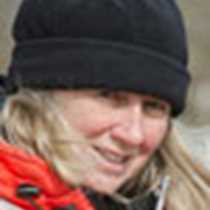The stair-step walls of the Palouse River canyon draw one's eyes skyward. It can't be helped. Although the planes of lava flows lie horizontally, the cooling fracture patterns lead ever higher. Some places are chunky, like piles of blocks created by a child. Colonnades are the carefully placed slats in a giant's picket fence. Whether carved into buttes or disappearing plateaus, the rocks force one to examine the heights beyond their edges. And there, against the deep blue, soar three forms. Long broad wings and a fan-shaped tail spell "buteo" to one versed in the language of birds. Add the presence of a dark leading edge on the wings and the words red-tailed hawk are clearly conveyed. Tiny forms, in flocks like gnats, stream from an alcove. They swirl together and drift down like smoke to the river's edge. Here the mud crawls with the flutter of wings, hundreds of wings. Each pair supports the weight of a delicate bird as it deftly pushes mud into a ball of just the right size and consistency to form the building bricks of a gourd-shaped nest. Together, on cue, the cliff swallows rise and follow each other back to the colony's chosen abode. Duos work to build their own homes but the masses are united as one, their many eyes constantly vigilant. Not far away an enemy waits. Fleet on the wing, a prairie falcon swoops down, hopeful of returning with a prize for its waiting mate. Background music for the aerial show is amplified by the canyon walls and echoes into the distance. The descending trill of a canyon wren is the introduction to symphonic movements played by brilliant Bullock's orioles and equally colorful black-headed grosbeaks. Sporting red epaulets, the red-winged blackbirds provide percussive events. Someone had forgotten to mention this was a formal event and we attended dressed in life vests and casual attire. But part of the audience arrived prepared for a ball. On the shoreline were a group of "party-colored plover(s) with head and neck of light brick-dust brown." At least this is these same birds were described in the journals of the Lewis and Clark expedition. Legs of blue-gray pranced in time to the music of the natural world. Rufous hoods were pulled over once white heads and napes. Wings flashed sharp patterns of black and white. A jaunty black up-turned bill completed the picture of the flock of American avocets. What a thrill!
Call +1.800.397.3348 or contact your travel advisor




